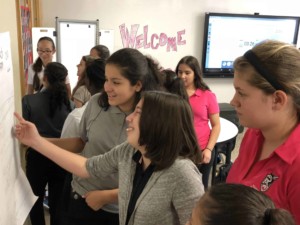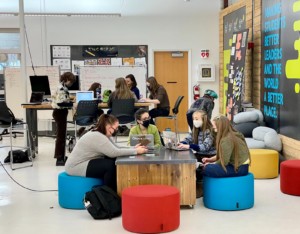The Implications of Gartner’s Top 10 Tech Trends of 2018 for Education – Part 2

This post is the second part of a two-part series. Catch up on the first part here.
By Jim Goodell, Liz Glowa and Brandt Redd
In October, Gartner released a report with predictions about the top tech trends for business in 2018. Education often falls behind the business world in realizing the potential of new technologies. There are, however, a few bright spots where the timing might be right for the tech trends in the business world to have a positive impact in education sooner rather than later.
We covered the first three trends according to Gartner in part one of this series. Below, we look at the remaining seven:
Digital: Blending the virtual and real worlds to create an immersive digitally enhanced and connected environment.
4) Digital Twins.
A digital twin is a digital representation of a real-world entity or system.
The most powerful application of this concept in education is as the digital representation of the “learner model” i.e. a digital model that can with increasingly detail represent what is going on inside the learner’s brain. This includes the learner’s conceptions and misconceptions, not only what competencies they’ve yet to master, but what misconceptions might be holding them back or what specific practice is needed to reach competency. A “digital twin” of a learner could better inform educators and inform technology tools like recommendation engines and formative feedback mechanisms within online learning activities. The best digital twin would also track what’s not known about the learner’s skills and might recommend activities to help discover those.
5) Cloud to the Edge.
In education there is a growing trend to use digital resources and blended learning models in which part of the learning is online. Resources and applications that might have been hosted locally in the past are moving into the cloud.
In many cases, this means the software is hosted centrally on big cloud platforms like the Amazon Web Services. According to Gartner, “edge computing describes a computing topology in which information processing and content collection and delivery are placed closer to the sources of this information.” One vision for cloud at the edge is a nano-server network that can adapt to changing needs in a more decentralized way. These nano-servers would exist in schools, homes, and businesses. Secure content and processing power would dynamically move between servers to be closer to the end-users that need it when they need it.
If this kind of nano-network becomes a reality, it might have implications for schools with broadband network challenges. Current limitations with internet bandwidth might be overcome if nano-servers are dynamically bringing content and applications closer to schools and learners’ homes.
Such a network might dynamic shift resources based on demand, e.g. different needs at different levels (elementary, secondary) and/or processes or models of teaching and learning.
“Occasionally connected computing” is a strategy already used in education to offer the benefits of the web applications with realities of the digital divide. For example, the ASSISTments app allows middle school math teachers to assign homework digitally. ASSISTments is primarily powered by a cloud-based service, but students can do homework even when not connected (such as on the bus home). The app will automatically sync when re-connected.
6) Conversational Platforms.
Conversational platforms, capable of answering simple questions, are evolving to be able to handle more complex interactions. “The challenge that conversational platforms face is that users must communicate in a very structured way, and this is often a frustrating experience.” https://www.gartner.com/smarterwithgartner/gartner-top-10-strategic-technology-trends-for-2018/
Beyond near-term applications within formal schooling, the evolution of these platforms for uses outside of schools has implications for what is important to learn inside of schools. Intelligent searching and analysis, evaluation and synthesis of information are critical skills. When the learning is augmented by ready access to global knowledge and machine learning through these conversational platforms, the strength on the human side is not in remembering facts but in asking the right questions and using the answers in creative ways.
We see potential applications of conversational platforms to education, such as:
- An agent that debates a student on a subject
- An agent that captures and analyzes oral testimony/report/assessment
- An agent that engages in a Socratic dialog,
- Combining a conversational platform with user interface and giving visual feedback, or with a camera to capture non-verbal cues from the learner.
One scenario is that the platform does the initial collection analysis for an oral report then the teacher can do additional comparison. An interesting opportunity is to use such technology to reinforce learning by helping learners process what they’ve been learning using guided metacognitive strategies.
7) Immersive Experience.
The kind of Augmented reality (AR), virtual reality (VR), and mixed reality that we see in other industries may be too expensive for contemporary schools to develop themselves as mainstream delivery models, but there is a lot of interest and funding for the applications that could provide economies of scale. There are some ways in which virtual experiences are already being used in schools; for example, virtual labs, virtual and interactive museum tours/field trips, simulations and problem-solving. AR allows teachers to enhance physical visual aids with virtual aids. One useful application of this is supplementing 2-D presentations with 3-D models that represent subjects more realistically and provide greater stimulation to the imagination. This also serves to boost student engagement.
A simulation-based tool for teacher training tool called simSchool has been used for more than 10 years to help teachers learn competencies like classroom management that can’t be taught as well in a lecture.
In some cases, such as with virtual labs, although the technology may be costly to develop at first, it reduces costs in the long run. Career and technical education may realize the benefits of AR and VR learning technologies sooner than academics as the initial development costs will be covered by the applicable industries. Some interesting applications are simulations to improve decision-making competencies and mixed reality to let students experience an early view of careers, such as simulations that enable students to “wear the shoes” of many occupational roles before stepping into them.
While there has been a lot of interest from venture capital in AR and VR this may be more of a horizon technology for education apart from of professional, military, and industrial training. As a well-funded emerging industry inside and outside education, there could be rapid advances to make it more accessible. The Ernest Cline’s novel, Ready Player One commences with a student attending school through virtual reality. In the fictional 2045, a VR school gives this underprivileged student a better experience than the physical alternative. As the movie comes out in late March it may provoke more consideration of this possibility.
Mesh providing the connections and connectability between people, organizations, devices, content and services to deliver outcomes that could previously not be achieved.
This technology provides schools the opportunity to build collaborative communities across agencies (health, social services) and stakeholders to meet the needs of the whole child. Some education-specific mesh technologies not in the Gartner report include some technologies being developed to support the growing use of digital education resources. The availability of intelligent digital resources, including open education resources, and the growth in use is something to watch in 2018.
8) Blockchain.
Blockchain is a distributed digital ledger in which financial or legal transactions (such as exchanging cryptocurrency like bitcoin) are publicly recorded. In the future, Blockchain might become important on the business side of education, but it has other applications, especially for secondary, higher education, and career and technical education providers. Although Blockchain was originally conceived as a way to support a decentralized digital currency and legal transactions, but it is also one of the technologies that make it possible to do portable verifiable digital credentials.
Why is this important in education? Because it is increasingly important for employers to know more than what the traditional diploma or transcript asserts about what a student knows or is able to do. Diplomas and transcripts are being replaced with digital Extended Transcripts, eCertificates, and Open Badges that provide a richer picture of a person’s learning outcomes.
Digital micro-credentials technologies such as Open Badges are being used to recognize skills that people develop through formal and informal learning experiences. For example, Digital Promise has built a system of micro-credentials to recognize educators for the skills they learn throughout their careers in order to craft powerful learning experiences for their students.
Some traditional transcripts are no longer available for another reason–more schools and colleges are going out of business. One solution is a verifiable digital record that cannot only confirm that a student completed a program or a set of courses, but what specific competencies that the institution asserted the student had upon graduation (before going out of business.) Some see blockchain technology as the way to have a portable verifiable digital credential that can continue to exist even if the institution that created it ceases to exist.
There may be less complex solutions than Blockchain that are equally effective for digital credentials. A World Wide Web Consortium (W3C) working group is looking into a solution for verifiable, portable credentials that may use technology like blockchain. One benefit that participants hope to offer is to allow the holder of the credential to be able to share as much or as few of the assertions that a digital credential contains. For example, I can choose not to share assertions about courses I’ve completed and competencies earned that I’m not proud of or have no relevance to the job for which I’m applying. The digital assertions I do choose to share can be verified using the Blockchain or other “mesh” technology, whether or not the issuing institution still exists.
9) Event-Driven.
In today’s world whenever something happens it is an “event” that might be captured as data. A smart device on a school bus marks attendance using the student id card. Another smart device marks the student attendance at school. A parent checks a parent portal or app to see that the student arrived then reads a comment from a teacher. The teacher assigns an online “do now” activity as the students arrive in class. Students use a school-provided or their own device to interact with an online problem set. Each click is captured as an “event.” Before the school bell rings to start the day multiple learning-related events have been captured as data. The data captured can be monitored by software to trigger other events. For example, if a student didn’t get on the bus when it pulls away from the expected stop the intelligent system might trigger other “events” such as a phone call to the parent and sending data to the school’s early warning system.
In education, xAPI and Caliper are two technology standards that are supporting the potential for “event-driven” efficiencies. These specifications make “click-stream” data from apps and the internet of things (IoT) available to AI and analytic processes to trigger early warning systems to inform educators and to trigger more valuable feedback to learners. (Caliper from IMS Global defines the data and how it is passed to and from learning management systems. xAPI originates from the ADL initiative and specifies an external Learning Record Store used in a distributed system. Both specifications allow for “profiles” of the data collected by different types of systems and for learner experiences, e.g. watching a video or taking an online test.)
The promise of event-driven for integrated systems of learning is that learner events can be detected, and with the help of AI, analyzed and more quickly and more specifically inform educators how to best help students so that each student has an equitable chance at success. Likewise, the event-driven systems have data to empower students, parents, and other stakeholders to take action on the student’s behalf.
10) Continuous Adaptive Risk and Trust.
This technology uses AI for real-time, risk and trust-based decision making for things like security and fraud protection. Adaptive risk and trust will have applications on the business side of education to inform better financial decision-making. It also could have applications on the security of physical campuses. This risk management function could also be applied to things like protecting student privacy, especially as more of the learning experience depends on online interactions.
Other EdTech Trends in 2018
Along with the “intelligent digital mesh,” we’d suggest keeping an eye on some additional education-specific trends in 2018: integrated systems to support student-centered learning, online collaborative learning/co-construction, technologies to support project-based learning, and technologies to support virtual and physical maker-spaces.
For more, see:
- The Implications of Gartner’s Top 10 Tech Trends of 2018 for Education (Part 1)
- Not Much New in EdTech in 2017; Three Things Could Change That in 2018
- Design Thinking and Its Impact on Education Innovation
Jim Goodell leads education data standards development for the U.S. Department of Education sponsored Common Education Data Standards (CEDS) initiative, and serves on the Project Unicorn Steering Committee.
Liz Glowa Ph.D. is a national expert on the technical design, strategic planning, and pedagogy of K–12 student-centered and online learning.
Brandt Redd serves as Chief Technology Officer for the Smarter Balanced Assessment Consortium, where he oversees the development and deployment of an open technology platform.
Stay in-the-know with all things EdTech and innovations in learning by signing up to receive the weekly Smart Update.





0 Comments
Leave a Comment
Your email address will not be published. All fields are required.